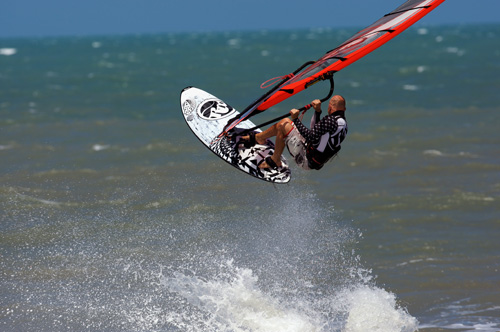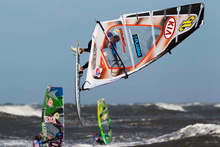
Jem Hall gives you a break from his fully frontside series to get you focusing on, believing in and enjoying the freedom of flight as he covers the basic jump. Photos by Dave White
As spring moves into summer l hope you’re all managing to get some sailing in – and, it goes without saying, doing so with passion. How are the tips working out? Are you working harder in light winds to get your fundamentals firing? What are the key tips that are helping you to be a better sailor? Have you considered getting equipment that will help you to improve faster? Are you thinking about travelling to get some much needed consistent conditions? Are you praying for some low pressure systems to ease your pain and put all these tips into practice? And finally, are you the pilot and not the passenger?
If indeed you are looking to move your sailing up, forwards and enjoy it more, then this article is for you as we’re now going to look at the basic jump. As you’re now looking to make changes to your sailing you will already have identified that you need to work on your mental preparation, tuning, gear selection, and, of course, application of technique.
If you’re not yet jumping then there’s no better way to take you out of your comfort zone then to get you airborne, and for those already getting it up regularly it’s time to do so more efficiently and with more height. There’s a great view to be had up there, and the higher you are the longer you get to enjoy it.
Many of you wannabe wavesailors may already be jumping a little when you flop off a wave or meaty bit of chop, but I’m now imploring you to put much more in, for what you reap is what you sow – and the more you sow the higher you go. Jumping higher and with more efficiency will give you more time and smooth your path to learn more radical jumps in the future. In some conditions making decent jumps is the difference between getting out the back and taking a beating – or a ‘learning experience’ as us coaches like to call it.
Jumping is one of the best parts of windsurfing; nailing your first jumps and getting fully confident in the air are memorable indeed. Chop-hops and wave jumps can be done before you’ve gained proficiency in many other moves (such as gybes and tacks), as once you have good speed in the straps on smaller boards you’re fully ready for some aerial action. Many lighter or younger sailors nail some sweet jumps but aren’t yet strong enough for some of the more powerful moves like carve gybes and hard-hitting waveriding.
Tuning
First up, your tuning is very important so be sure to check out my Jem’s Gems section. Your board selection should be 111L and downwards, and freestyle-wave, freestyle or a waveboard, as their rockerlines are more eager to take off.
Analyse this… and that
To get properly airborne a bit of a ramp is handy, so you’ll need to analyse the water for some juicy lumps and bumps. Just as wind awareness and really seeing gusts and lulls helps your stance and board speed, so too does seeking out the most suitable ramps. These observations are the first part of your journey into airtime action.
Fasten seatbelts and prepare for take-off
Your take-off will be slightly into the wind and with board’s tail in the trough, which brings the nose up and feeds air under the board. However, speed is your friend here so your sailing line shouldn’t be upwind for too long. More speed means more height and the more you put into taking off the more you get out. The board will not jump for you, so you have to be the pilot not the passenger and give the kit the technique that is required to get it airborne.
The biggest tip to get you off the water is that your stance should be quite different pre-jump to ensure that the kit’s in the right position for taking-off. This is the most major change you’ll make in jumping well, so forget about being outboard and motoring – think more about getting over the board and be ready to ‘ollie’ as you would in other boardsports. Read on for the nitty gritty…




